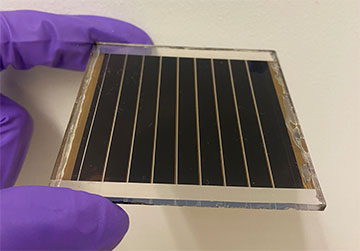
A perovskite solar module with an active area of 22.0 cm2 containing fluorinated aniliniums for interfacial passivation. [Image: C. Liu, Northwestern University]
Metal-halide perovskite solar cells (PSCs) have quickly become a leading candidate to replace crystalline silicon devices, boasting the advantages of high power-conversion efficiency and low processing cost. However, the major challenge with PSCs is operating instability, particularly at high temperatures, which significantly reduces their lifespan.
Now, an international team of researchers says it has discovered a novel approach to minimize PSC degradation at elevated temperatures (Science, doi: 10.1126/science.adi4107). With the help of fluorinated ammonium ligands, an encapsulated device was able to maintain 85% of its efficiency at 85°C and 50% relative humidity after 1,560 hours of operation.
Improving on interfaces
PSC interfaces have high defect densities and low barriers to ion transfer, which leads to performance losses. Interface passivation engineering provides an effective solution to this issue by creating an outer layer of shield material on top of the perovskite layer. Passivation reduces the chemical reactivity of the surface and eliminates dangling bonds and other defects.
PSCs with record-setting efficiency have been achieved with the help of interface passivation engineering—specifically, a 2D perovskite layer that terminates the 3D perovskite surface. This 2D/3D hybrid structure is formed by exposing the 3D surface to a solution containing ammonium ligands, which fragment the 3D lattice into 2D layers.
Michael Grätzel of EPFL, Switzerland, and his colleagues wondered if some ammonium ligands could penetrate deeper into the 3D perovskite surface than others and contribute to deterioration, especially in more demanding environmental conditions. They decided to test a library of ammonium ligands with varying tail groups and alkyl chain lengths, hoping to find one that would be minimally invasive.
Among the most stable
The researchers employed angle-resolved X-ray photoelectron spectroscopy and time-of-flight secondary-ion mass spectrometry to probe the spatial distribution of different ammonium ligands at 100°C. They discovered that a small-sized ammonium ligand, anilinium, had the lowest reactivity with 3D perovskites. In addition, fluorination of anilinium derivatives was shown to boost interfacial passivation.
With various tweaks to their encapsulated PSC, the researchers reported a maximum power-conversion efficiency of 19.9% at 85°C and 50% relative humidity after 1,560 hours of maximum power point operation.
Grätzel and his colleagues then studied the operating stability of PSCs with the addition of fluorinated anilinium using International Summit on Organic Photovoltaic Stability (ISOS) protocols. With various tweaks to their encapsulated PSC, the researchers reported a maximum power-conversion efficiency of 19.9% at 85°C and 50% relative humidity after 1,560 hours of maximum power point operation. The devices are among the most stable PSCs seen under ISOS protocols at that temperature.
The latest result brings the terawatt-scale deployment of PSCs closer to reality, according to the press release accompanying the paper.
